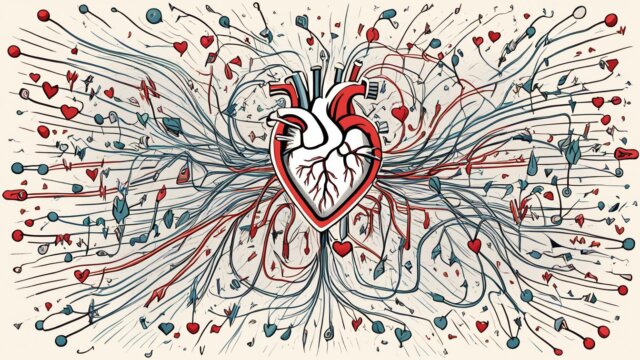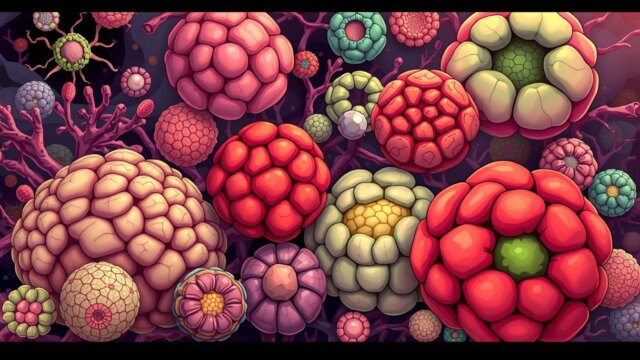FTC disclaimer: This post may contains affiliate links and we will be compensated if you click on a link and make a purchase.
Did you know cholangiocarcinoma is a rare cancer of the bile ducts? It makes up only 3% of all gastrointestinal cancers in the United States. Yet, it’s growing fast, with cases going up by nearly 2% each year. Knowing the symptoms, causes, and treatments is key for early detection and better outcomes.
Cholangiocarcinoma, or bile duct cancer, grows in the ducts that carry bile from the liver to the small intestine. It mostly hits adults over 65. By the time it’s found, it’s often too late, making treatment hard. Symptoms include jaundice, itchy skin, belly pain, fever, weight loss, weakness, and a swollen gallbladder.
Doctors use blood tests and imaging scans to find cholangiocarcinoma. They check liver function and look for cancer markers like CEA and CA19-9. Scans like ultrasound, CT, MRI, and PET help see the tumors. Endoscopic tests like ERCP and EUS also help diagnose.
Key Takeaways
- Cholangiocarcinoma is a rare and aggressive form of cancer that affects the bile ducts, responsible for only 3% of all gastrointestinal cancers in the United States.
- Symptoms of bile duct cancer can include jaundice, itchy skin, abdominal pain, fever, weight loss, and a distended gallbladder.
- Diagnosis involves a combination of blood tests, imaging scans, and endoscopic procedures to detect and evaluate the tumor.
- Surgical removal is the primary treatment option, providing the potential for complete cure, with additional treatments like endoscopic therapy and radiologic therapy available.
- Bile duct cancer is most commonly diagnosed in people over the age of 65, with men and women affected almost equally.
What is Cholangiocarcinoma?
Cholangiocarcinoma, also known as bile duct cancer, is a rare and aggressive cancer. It forms in the bile ducts. The bile ducts carry bile from the liver and gallbladder to the small intestine. There are three main types of cholangiocarcinoma based on where the tumor is in the bile ducts.
Definition and Overview
Cholangiocarcinoma is another name for bile duct cancer. It’s a rare cancer, with about 8,000 to 10,000 new cases each year in the U.S.. Intrahepatic bile duct cancer is very rare. Extrahepatic bile duct cancer includes perihilar and distal bile duct cancer.
Perihilar bile duct cancer is at the junction of the right and left bile ducts. Distal bile duct cancer is where the ducts from the liver and gallbladder merge.
Types of Cholangiocarcinoma
Bile duct cancer, or cholangiocarcinoma, can start anywhere in the bile duct system. It’s divided into three types based on location. The most common liver cancer is hepatocellular carcinoma, not cholangiocarcinoma.
Nearly all bile duct cancers are cholangiocarcinomas, a type of adenocarcinoma. Other rare types include sarcomas, lymphomas, and small cell cancers. Non-cancerous tumor types include bile duct hamartomas and adenomas.
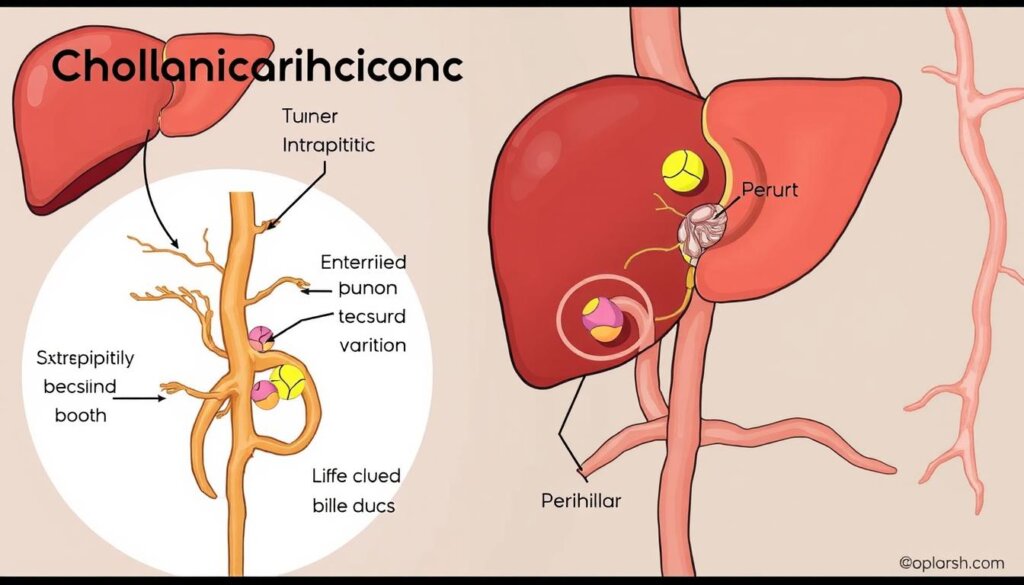
Symptoms of Cholangiocarcinoma
Cholangiocarcinoma is a rare bile duct cancer. It often doesn’t show symptoms until it’s too late. But knowing the signs can help catch it early. The main symptoms are jaundice, itchy skin, abdominal pain, and weight loss.
Jaundice and Itchy Skin
Jaundice makes the skin and eyes turn yellow. It happens when bile ducts get blocked. This blocks bilirubin, causing itchy skin.
Abdominal Pain and Weight Loss
Abdominal pain, especially on the right side, is a symptom. People with this cancer may also lose weight without trying. They might feel feverish and nauseous too.
Seeing a doctor right away is key if you notice these signs. Early treatment is crucial for a good outcome.

Jaundice is common, but it’s often not cancer. Other signs include light-colored stools and dark urine.
“It’s essential to consult a doctor immediately if any of these symptoms occur, as they can be indicators of underlying problems that require prompt treatment.”
Causes and Risk Factors
Cholangiocarcinoma, a bile duct cancer, has no clear cause. But, many risk factors have been found to increase the chance of getting it.
Chronic Liver Diseases
Chronic liver issues like primary sclerosing cholangitis (PSC) and cirrhosis raise the risk of cholangiocarcinoma. People with these conditions should get regular check-ups. This helps find bile duct cancer early.
Age, Smoking, and Genetics
Most cholangiocarcinoma cases happen in people over 60. Smoking is a big risk factor, as it’s linked to this cancer. Some genetic conditions, like cystic fibrosis and Lynch syndrome, also raise the risk.
In places like Southeast Asia and China, liver fluke infections play a role in cholangiocarcinoma. Other risks include obesity, non-alcoholic fatty liver disease, diabetes, and exposure to harmful chemicals.
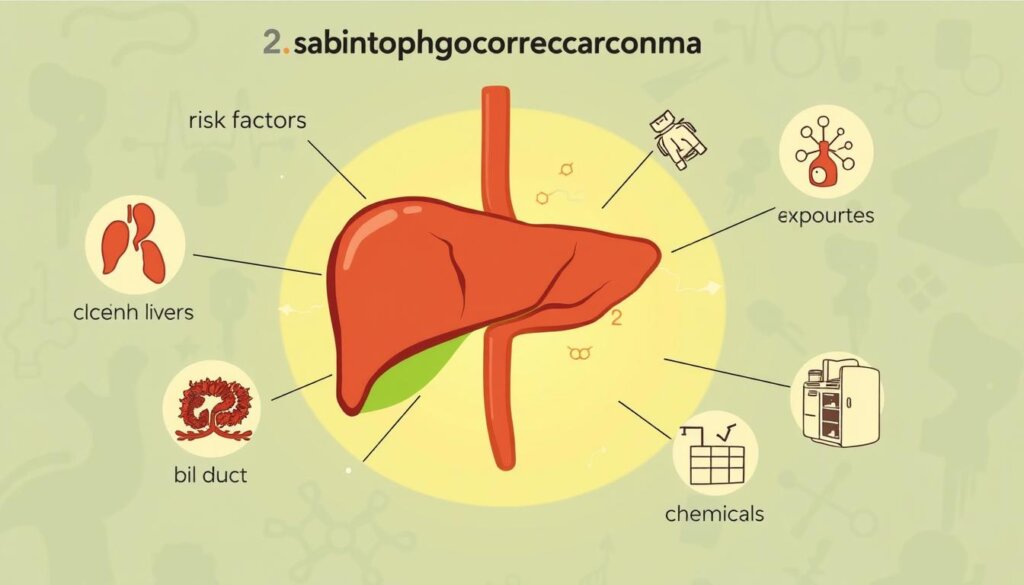
“Understanding the underlying causes and risk factors of cholangiocarcinoma is crucial for early detection, effective management, and ultimately, improving patient outcomes.”
Cholangiocarcinoma Diagnosis
Diagnosing cholangiocarcinoma, a bile duct cancer, is hard. It often grows quietly and is found late. But, imaging tests and biopsies are key in spotting it.
ERCP is a common test. It uses a thin tube with a camera to see the bile and pancreatic ducts. Endoscopic ultrasound makes images with sound waves. Blood tests for carbohydrate antigen (CA) 19-9 also help diagnose it.
Ultrasound, CT scans, and MRI/MRCP are important for finding bile duct cancer. They spot any oddities in the bile ducts and nearby areas. Sometimes, a biopsy is needed to check a tumor sample.
Diagnostic Test | Description |
|---|---|
Endoscopic Retrograde Cholangiopancreatography (ERCP) | A procedure that uses a flexible tube with a camera to examine the bile ducts and pancreatic ducts. |
Endoscopic Ultrasound | A procedure that uses sound waves to generate images of nearby tissues, including the bile ducts. |
Carbohydrate Antigen (CA) 19-9 Blood Test | A blood test that can help diagnose cholangiocarcinoma by measuring the levels of a specific protein. |
Imaging Tests (Ultrasound, CT Scan, MRI/MRCP) | Various imaging techniques used to detect abnormalities in the bile ducts and surrounding structures. |
Biopsy | A procedure where a small sample of the tumor is taken for analysis to confirm the diagnosis and determine the type of cholangiocarcinoma. |
Knowing about the tests for cholangiocarcinoma is key for early detection and treatment.
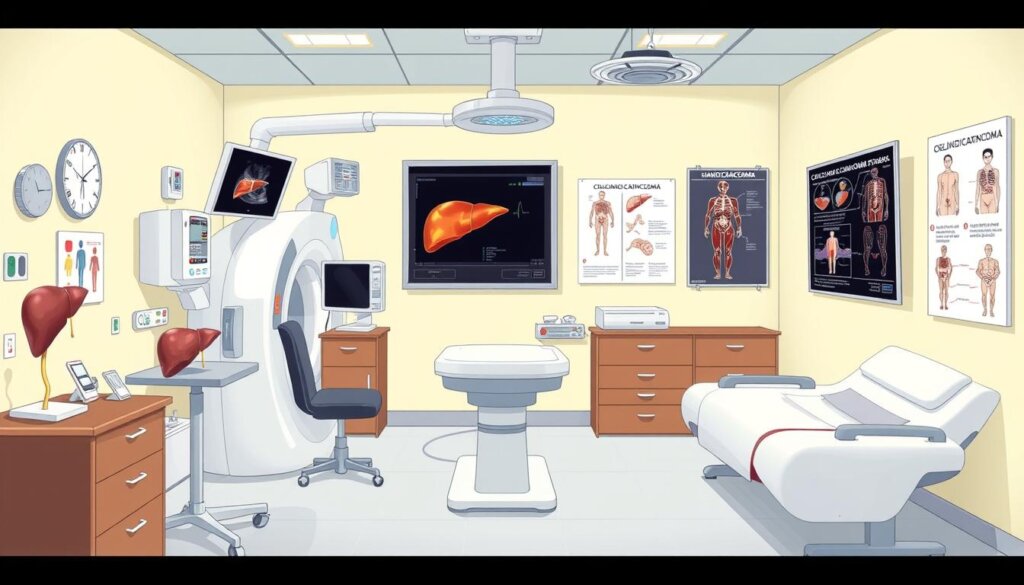
Treatment Options for Cholangiocarcinoma
Cholangiocarcinoma is a rare and aggressive liver cancer. Its treatment depends on the cancer’s stage, location, and the patient’s health. For early-stage cancers, surgery to remove the tumor and bile ducts is an option. But, most cancers are too advanced to be removed by surgery.
Surgery
Surgery is best for cancers that can be removed, like stage 0, I, and II cancers. After surgery, radiation and chemotherapy may be used to prevent cancer from coming back.
Chemotherapy and Radiation Therapy
For cancers that can’t be removed, chemotherapy is the main treatment. Drugs like gemcitabine and cisplatin are often used. Radiation therapy is also common, with treatment plans based on the tumor’s size and location.
New treatments like durvalumab and ivosidenib are being tested in clinical trials. These may offer better chances for patients with this rare disease.
For advanced cancers, treatments like intra-arterial embolization may be used. In some cases, a liver transplant is an option for perihilar bile duct cancer.
Clinical trials offer new treatments for cholangiocarcinoma. They may improve a patient’s chances of recovery.
“Surgery is the preferred treatment for resectable cancers if possible, but radiation therapy and/or chemotherapy are often used in combination with surgery or as the primary treatment for advanced or inoperable cholangiocarcinoma.”
Treatment Modality | Description |
|---|---|
Surgery | Removal of the tumor and affected bile ducts, often followed by radiation therapy and/or chemotherapy to lower the risk of recurrence. |
Chemotherapy | Common chemotherapy drugs used for bile duct cancer include gemcitabine, cisplatin, capecitabine, and oxaliplatin. |
Radiation Therapy | External beam radiation therapy is a common treatment for bile duct cancer, with the duration and intensity based on the tumor’s size and location. |
Targeted Therapy and Immunotherapy | Newer treatments like durvalumab, pembrolizumab, ivosidenib, and pemigatinib are being explored in clinical trials for bile duct cancer. |
Specialized Procedures | Intra-arterial embolization and liver transplant may be considered for certain unresectable or recurrent bile duct cancers. |
Treatment options for cholangiocarcinoma are getting better. Ongoing research and clinical trials are looking for new ways to help patients.
Prevention of Cholangiocarcinoma
There’s no guaranteed way to stop cholangiocarcinoma, but healthy habits and screenings can lower your risk. It’s key to take steps to prevent it. Cholangiocarcinoma is a common bile duct cancer, ranking fifth in cancer deaths in the U.S..
Lifestyle Changes
Stopping smoking and drinking less alcohol are big steps in preventing cholangiocarcinoma. Smoking raises liver cancer risk, with more cigarettes and longer smoking leading to higher risks. Drinking too much alcohol also increases liver cancer risk, especially with cirrhosis.
Keeping your liver healthy is also vital. Avoid too much alcohol and manage chronic liver diseases like primary sclerosing cholangitis. Rare conditions like untreated hereditary hemochromatosis, Alpha-1-antitrypsin deficiency, and Wilson disease also raise liver cancer risk and need proper care.
Regular Screening
For those with risk factors like primary sclerosing cholangitis, regular checks can catch cholangiocarcinoma early. Early detection is key for better treatment chances. Vaccines against Hepatitis B and treating chronic Hepatitis B can also lower liver cancer risk.
Also, avoiding toxins like Aflatoxin B1 in foods stored in hot, humid places can help prevent cholangiocarcinoma.
By changing your lifestyle and getting regular screenings, you can lower your risk of this tough cancer.
Living with Cholangiocarcinoma
Living with cholangiocarcinoma, a rare bile duct cancer, is tough. But, managing symptoms and keeping a good quality of life is possible. Those with advanced cancer face a tough road, as treatment aims to slow the cancer’s growth and ease symptoms. Sadly, most are diagnosed when the cancer has spread, making surgery hard.
Managing symptoms like jaundice, itching, and pain is key for a good life. Pain from bile duct cancer can be managed with the right painkillers. The emotional toll of a diagnosis can be huge, causing feelings of confusion, anger, fear, and sadness.
Getting support from healthcare, support groups, and loved ones is vital. Nurses specializing in symptom control and palliative care are crucial for advanced cancer patients. Family and friends offer essential support, helping manage the disease’s challenges.
Local hospices, GP surgeries, and charities provide emotional and practical help. Community services like nurses and social workers help give comprehensive care.
Living with cholangiocarcinoma is complex but manageable with the right support. Many questions about diagnosis and treatment can be discussed with healthcare providers.
Regular check-ups and monitoring are key for those treated for cholangiocarcinoma. Doctors may suggest blood and imaging tests every 6 months for a couple of years. A healthy lifestyle, including exercise, a balanced diet, and not smoking, can also help.
Emotional support from friends, family, support groups, and counselors can ease depression, anxiety, or worry. Survivorship care plans include follow-up exams, diet and activity guidelines, and reminders for doctor visits. Having good health insurance is also important to cover costs.
“Living with cholangiocarcinoma requires a holistic approach, addressing both the physical and emotional challenges. With the right support and management strategies, individuals can strive to maintain the best possible quality of life.”
By working with their healthcare team and using available resources, individuals can face the challenges of cholangiocarcinoma.
Clinical Trials and Research
Doctors and scientists are always trying to find better ways to treat cholangiocarcinoma. This rare cancer affects the bile ducts and is becoming more common in the U.S.. It has unique immune systems in tumors and different genes in different parts, making it hard to treat.
They are looking for ways to catch cholangiocarcinoma early. They are studying tumor DNA to help diagnose and track the disease. Liquid biopsies, which check DNA in blood or bile, are also being tested for early detection and monitoring.
New treatments like chemotherapy, targeted therapy, and immunotherapy are being explored. These treatments target specific genetic changes in tumors. Immunotherapy is also being studied for its potential in treating cholangiocarcinoma.
Many clinical trials are looking at new treatments for cholangiocarcinoma. These include drugs like bevacizumab, atezolizumab, Futibatinib, and zanidatamab. These trials are happening in different places and are in various stages, focusing on specific genetic changes in bile duct cancers.
FAQ
What is cholangiocarcinoma?
What are the different types of cholangiocarcinoma?
What are the common symptoms of cholangiocarcinoma?
What are the risk factors for developing cholangiocarcinoma?
How is cholangiocarcinoma diagnosed?
What are the treatment options for cholangiocarcinoma?
How can cholangiocarcinoma be prevented?
How can individuals living with cholangiocarcinoma manage their symptoms and quality of life?
What are the latest developments in cholangiocarcinoma research and treatment?
Source Links
- https://www.hopkinsmedicine.org/health/conditions-and-diseases/bile-duct-cancer-cholangiocarcinoma
- https://www.nhsinform.scot/illnesses-and-conditions/cancer/cancer-types-in-adults/bile-duct-cancer-cholangiocarcinoma/
- https://www.cancer.gov/types/liver/bile-duct-cancer
- https://www.cancer.org/cancer/types/bile-duct-cancer/about/what-is-bile-duct-cancer.html
- https://www.cancer.org/cancer/types/bile-duct-cancer/detection-diagnosis-staging/signs-symptoms.html
- https://www.ncbi.nlm.nih.gov/pmc/articles/PMC3125451/
- https://www.cancer.org/cancer/types/bile-duct-cancer/causes-risks-prevention/risk-factors.html
- https://www.moffitt.org/cancers/cholangiocarcinoma-bile-duct-cancer/diagnosis/risk-factors/
- https://www.mayoclinic.org/diseases-conditions/cholangiocarcinoma/diagnosis-treatment/drc-20352413
- https://www.ncbi.nlm.nih.gov/pmc/articles/PMC9858255/
- https://www.ncbi.nlm.nih.gov/pmc/articles/PMC2504383/
- https://www.cancer.org/cancer/types/bile-duct-cancer/treating/based-on-situation.html
- https://www.cancer.gov/types/liver/bile-duct-cancer/treatment
- https://www.ncbi.nlm.nih.gov/pmc/articles/PMC8773654/
- https://ruesch.georgetown.edu/bileductcancerprevention/
- https://www.ncbi.nlm.nih.gov/pmc/articles/PMC2954129/
- https://www.cancerresearchuk.org/about-cancer/bile-duct-cancer/living-with/advanced
- https://www.cancer.org/cancer/types/bile-duct-cancer/after-treatment/follow-up.html
- https://cancerblog.mayoclinic.org/2024/01/10/research-fuels-advances-in-bile-duct-cancer-care/
- https://cholangiocarcinoma.org/clinical-trials/
- https://clinicaltrials.ucsd.edu/cholangiocarcinoma

